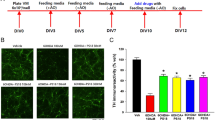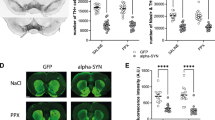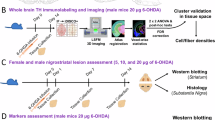Abstract
Aim:
To investigate the protective effects of octacosanol in 6-hydroxydopamine-induced Parkinsonian rats and find whether octacosanol has effects on pro nerve growth factor (pro-NGF), NGF and the downstream effector proteins.
Methods:
Behavioral tests, enzymatic assay, tyrosine hydroxylase immunohistochemistry, TUNEL and Western blot were used to investigate the effects of octacosanol in this rat model of PD.
Results:
Oral administration of octacosanol (35–70 mg/kg, po for 14 d) significantly improved the behavioral impairments in rats induced by 6-OHDA and dose-dependently preserved the free radical scavenging capability of the striatum. Octacosanol treatment also effectively ameliorated morphological appearances of TH-positive neuronal cells in nigrostriatal systems and decreased the apoptotic cells induced by 6-OHDA in striatum. In addition, octacosanol strikingly blocked the 6-OHDA-induced increased expression of proNGF-p75NTR-sortilin death signaling complex and its downstream effector proteins. Meantime, octacosanol prevented the decreased levels of NGF, its receptors TrkA and p-Akt which together mediated the cell survival pathway.
Conclusion:
The findings implicated that the anti-parkinsonism effects afforded by octacosanol might be mediated by its neuro-microenvironment improving potency through retrieving the ratios of proNGF:NGF and the respective receptors p75NTR:TrkA in vivo. Due to its excellent tolerability and non-toxicity, octacosanol may be a promising agent for PD treatment.
Similar content being viewed by others
Log in or create a free account to read this content
Gain free access to this article, as well as selected content from this journal and more on nature.com
or
Abbreviations
- 6-OHDA:
-
6-hydroxydopamine
- AD:
-
Alzheimer's disease
- BSA:
-
bovine serum albumin
- CMC:
-
carboxymethylcellulose sodium
- CAT:
-
catalase
- DA:
-
dopamine
- DAB:
-
3,3′-diaminobenzidine
- GSH-Px:
-
glutathione peroxidase
- JNK:
-
Jun kinase
- L-dopa:
-
levodopa
- MDA:
-
malondialdehyde
- NGF:
-
nerve growth factor
- Ocs:
-
Octacosanol
- PBS:
-
phosphate buffered saline
- PD:
-
Parkinson's disease
- ProNGF:
-
precursor of nerve growth factor
- prot.:
-
protein
- ROS:
-
reactive oxygen species
- SN:
-
substantia nigra
- SOD:
-
superoxide dismutase
- TH:
-
tyrosine hydroxylase
- TUNEL:
-
Terminal deoxynucleotidyl transferase-mediated dUTP Nick End Labeling assay
References
Hirsch E, Graybiel AM, Agid YA . Melanized dopaminergic neurons are differentially susceptible to degeneration in Parkinson's disease. Nature 1988; 334: 345–8.
Jenner P, Olanow CW . Oxidative stress and the pathogenesis of Parkinson's disease. Neurology 1996; 47: S161–70.
Sherer TB, Betarbet R, Greenamyre JT . Pathogenesis of Parkinson's disease. Curr Opin Investig Drugs 2001; 2: 657–62.
Blum D, Torch S, Lambeng N, Nissou M, Benabid AL, Sadoul R, et al. Molecular pathways involved in the neurotoxicity of 6-OHDA, dopamine and MPTP: contribution to the apoptotic theory in Parkinson's disease. Prog Neurobiol 2001; 65: 135–72.
Schober A . Classic toxin-induced animal models of Parkinson's disease: 6-OHDA and MPTP. Cell Tissue Res 2004; 318: 215–24.
Lee R, Kermani P, Teng KK, Hempstead BL . Regulation of cell survival by secreted proneurotrophins. Science 2001; 294: 1945–8.
Nykjaer A, Lee R, Teng KK, Jansen P, Madsen P, Nielsen MS, et al. Sortilin is essential for proNGF-induced neuronal cell death. Nature 2004; 427: 843–8.
Harrington AW, Leiner B, Blechschmitt C, Arevalo JC, Lee R, Morl K, et al. Secreted proNGF is a pathophysiological death-inducing ligand after adult CNS injury. Proc Natl Acad Sci U S A 2004; 101: 6226–30.
Teng HK, Teng KK, Lee R, Wright S, Tevar S, Almeida RD, et al. ProBDNF induces neuronal apoptosis via activation of a receptor complex of p75NTR and sortilin. J Neurosci 2005; 25: 5455–63.
Casaccia-Bonnefil P, Carter BD, Dobrowsky RT, Chao MV . Death of oligodendrocytes mediated by the interaction of nerve growth factor with its receptor p75. Nature 1996; 383: 716–9.
Yoon SO, Casaccia-Bonnefil P, Carter B, Chao MV . Competitive signaling between TrkA and p75 nerve growth factor receptors determines cell survival. J Neurosci 1998; 18: 3273–81.
Bamji SX, Majdan M, Pozniak CD, Belliveau DJ, Aloyz R, Kohn J, et al. The p75 neurotrophin receptor mediates neuronal apoptosis and is essential for naturally occurring sympathetic neuron death. J Cell Biol 1998; 140: 911–23.
Friedman WJ . Neurotrophins induce death of hippocampal neurons via the p75 receptor. J Neurosci 2000; 20: 6340–6.
Roux PP, Bhakar AL, Kennedy TE, Barker PA . The p75 neurotrophin receptor activates Akt (protein kinase B) through a phosphatidylinositol 3-kinase-dependent pathway. J Biol Chem 2001; 276: 23097–104.
Tournier C, Hess P, Yang DD, Xu J, Turner TK, Nimnual A, et al. Requirement of JNK for stress-induced activation of the cytochrome c-mediated death pathway. Science 2000; 288: 870–4.
Salehi AH, Xanthoudakis S, Barker PA . NRAGE, a p75 neurotrophin receptor-interacting protein, induces caspase activation and cell death through a JNK-dependent mitochondrial pathway. J Biol Chem 2002; 277: 48043–50.
Yao R, Cooper GM . Requirement for phosphatidylinositol-3 kinase in the prevention of apoptosis by nerve growth factor. Science 1995; 267: 2003–6.
Kato S, Karino K, Hasegawa S, Nagasawa J, Nagasaki A, Eguchi M, et al. Octacosanol affects lipid metabolism in rats fed on a high-fat diet. Br J Nutr 1995; 73: 433–41.
Taylor JC, Rapport L, Lockwood GB . Octacosanol in human health. Nutrition 2003; 19: 192–5.
Snider SR . Octacosanol in parkinsonism. Ann Neurol 1984; 16: 723.
Lee CS, Sauer H, Bjorklund A . Dopaminergic neuronal degeneration and motor impairments following axon terminal lesion by instrastriatal 6-hydroxydopamine in the rat. Neuroscience 1996; 72: 641–53.
Allbutt HN, Henderson JM . Use of the narrow beam test in the rat, 6-hydroxydopamine model of Parkinson's disease. J Neurosci Methods 2007; 159: 195–202.
Ji C, Aisa HA, Yang N, Li Q, Wang T, Zhang L, et al. Gossypium herbaceam extracts inhibited NF-kappaB activation to attenuate spatial memory impairment and hippocampal neurodegeneration induced by amyloid-beta in rats. J Alzheimers Dis 2008; 14: 271–83.
Beattie MS, Harrington AW, Lee R, Kim JY, Boyce SL, Longo FM, et al. ProNGF induces p75-mediated death of oligodendrocytes following spinal cord injury. Neuron 2002; 36: 375–86.
Bhakar AL, Howell JL, Paul CE, Salehi AH, Becker EB, Said F, et al. Apoptosis induced by p75NTR overexpression requires Jun kinase-dependent phosphorylation of Bad. J Neurosci 2003; 23: 11373–81.
Buschmann T, Adler V, Matusevich E, Fuchs SY, Ronai Z . p53 phosphorylation and association with murine double minute 2, c-Jun NH2-terminal kinase, p14ARF, and p300/CBP during the cell cycle and after exposure to ultraviolet irradiation. Cancer Res 2000; 60: 896–900.
Fuchs SY, Adler V, Pincus MR, Ronai Z . MEKK1/JNK signaling stabilizes and activates p53. Proc Natl Acad Sci USA 1998; 95: 10541–6.
Donovan N, Becker EB, Konishi Y, Bonni A . JNK phosphorylation and activation of BAD couples the stress-activated signaling pathway to the cell death machinery. J Biol Chem 2002; 277: 40944–9.
Konishi Y, Lehtinen M, Donovan N, Bonni A . Cdc2 phosphorylation of BAD links the cell cycle to the cell death machinery. Mol Cell 2002; 9: 1005–16.
Cui QL, Fogle E, Almazan G . Muscarinic acetylcholine receptors mediate oligodendrocyte progenitor survival through Src-like tyrosine kinases and PI3K/Akt pathways. Neurochem Int 2006; 48: 383–93.
Menendez R, Fraga V, Amor AM, Gonzalez RM, Mas R . Oral administration of policosanol inhibits in vitro copper ion-induced rat lipoprotein peroxidation. Physiol Behav 1999; 67: 1–7.
Menendez R, Mas R, Amor AM, Gonzalez RM, Fernandez JC, Rodeiro I, et al. Effects of policosanol treatment on the susceptibility of low density lipoprotein (LDL) isolated from healthy volunteers to oxidative modification in vitro. Br J Clin Pharmacol 2000; 50: 255–62.
Ohta Y, Ohashi K, Matsura T, Tokunaga K, Kitagawa A, Yamada K . Octacosanol attenuates disrupted hepatic reactive oxygen species metabolism associated with acute liver injury progression in rats intoxicated with carbon tetrachloride. J Clin Biochem Nutr 2008; 42: 118–25.
Noa M, Herrera M, Magraner J, Mas R . Effect of policosanol on isoprenaline-induced myocardial necrosis in rats. J Pharm Pharmacol 1994; 46: 282–5.
Molina V, Arruzazabala ML, Carbajal D, Valdes S, Noa M, Mas R, et al. Effect of policosanol on cerebral ischemia in Mongolian gerbils. Braz J Med Biol Res 1999; 32: 1269–76.
Dexter DT, Carter CJ, Wells FR, Javoy-Agid F, Agid Y, Lees A, et al. Basal lipid peroxidation in substantia nigra is increased in Parkinson's disease. J Neurochem 1989; 52: 381–9.
Alam ZI, Jenner A, Daniel SE, Lees AJ, Cairns N, Marsden CD, et al. Oxidative DNA damage in the parkinsonian brain: an apparent selective increase in 8-hydroxyguanine levels in substantia nigra. J Neurochem 1997; 69: 1196–203.
Alam ZI, Daniel SE, Lees AJ, Marsden DC, Jenner P, Halliwell B . A generalised increase in protein carbonyls in the brain in Parkinson's but not incidental Lewy body disease. J Neurochem 1997; 69: 1326–9.
Floor E, Wetzel MG . Increased protein oxidation in human substantia nigra pars compacta in comparison with basal ganglia and prefrontal cortex measured with an improved dinitrophenylhydrazine assay. J Neurochem 1998; 70: 268–75.
Andrew R, Watson DG, Best SA, Midgley JM, Wenlong H, Petty RK . The determination of hydroxydopamines and other trace amines in the urine of parkinsonian patients and normal controls. Neurochem Res 1993; 18: 1175–7.
Friedman WJ, Greene LA . Neurotrophin signaling via Trks and p75. Exp Cell Res 1999; 253: 131–42.
Hennigan A, O'Callaghan RM, Kelly AM . Neurotrophins and their receptors: roles in plasticity, neurodegeneration and neuroprotection. Biochem Soc Trans 2007; 35: 424–7.
Huang EJ, Reichardt LF . Trk receptors: roles in neuronal signal transduction. Annu Rev Biochem 2003; 72: 609–42.
Deshmukh M . Johnson EM Jr . Programmed cell death in neurons: focus on the pathway of nerve growth factor deprivation-induced death of sympathetic neurons. Mol Pharmacol 1997; 51: 897–906.
Takadera T, Ohyashiki T . Apoptotic cell death and CPP32-like activation induced by thapsigargin and their prevention by nerve growth factor in PC12 cells. Biochim Biophys Acta 1998; 1401: 63–71.
Andsberg G, Kokaia Z, Bjorklund A, Lindvall O, Martinez-Serrano A . Amelioration of ischaemia-induced neuronal death in the rat striatum by NGF-secreting neural stem cells. Eur J Neurosci 1998; 10: 2026–36.
Lorigados Pedre L, Pavon Fuentes N, Alvarez Gonzalez L, McRae A, Serrano Sanchez T, Blanco Lescano L, et al. Nerve growth factor levels in Parkinson disease and experimental parkinsonian rats. Brain Res 2002; 952: 122–7.
Jackson GR, Werrbach-Perez K, Ezell EL, Post JF, Perez-Polo JR . Nerve growth factor effects on pyridine nucleotides after oxidant injury of rat pheochromocytoma cells. Brain Res 1992; 592: 239–48.
Halvorsen EM, Dennis J, Keeney P, Sturgill TW, Tuttle JB, Bennett JB Jr . Methylpyridinium MPP+- and nerve growth factor-induced changes in pro- and anti-apoptotic signaling pathways in SH-SY5Y neuroblastoma cells. Brain Res, 2002; 952: 98–110.
Salinas M, Diaz R, Abraham NG, Ruiz de Galarreta CM, Cuadrado A . Nerve growth factor protects against 6-hydroxydopamine-induced oxidative stress by increasing expression of heme oxygenase-1 in a phosphatidylinositol 3-kinase-dependent manner. J Biol Chem 2003; 278: 13898–904.
Fahnestock M, Yu G, Michalski B, Mathew S, Colquhoun A, Ross GM, et al. The nerve growth factor precursor proNGF exhibits neurotrophic activity but is less active than mature nerve growth factor. J Neurochem 2004; 89: 581–92.
Althaus HH, Kloppner S . Mature pig oligodendrocytes rapidly process human recombinant pro-nerve growth factor and do not undergo cell death. J Neurochem 2006; 98: 506–17.
Boutilier J, Ceni C, Pagdala PC, Forgie A, Neet KE, Barker PA . Proneurotrophins require endocytosis and intracellular proteolysis to induce TrkA activation. J Biol Chem 2008; 283: 12709–16.
Sobottka B, Reinhardt D, Brockhaus M, Jacobsen H, Metzger F . ProNGF inhibits NGF-mediated TrkA activation in PC12 cells. J Neurochem 2008; 107: 1294–303.
Aleman CL, Mas R, Hernandez C, Rodeiro I, Cerejido E, Noa M, et al. A 12-month study of policosanol oral toxicity in Sprague Dawley rats. Toxicol Lett 1994; 70: 77–87.
Fernandez L, Mas R, Illnait J, Fernandez JC . Policosanol: results of a postmarketing surveillance study of 27,879 patients. Curr Ther Res Clin Exp 1998; 59: 717–22.
Acknowledgements
This work was supported by the grant from the National Basic Research Development Program of China (2007CB507400) and National High Technology Research and Development Program of China (2006AA02A408). This research was also supported by grants from the National 973 Fundamental Project of China, Grant Number (2009CB523004), We are indebted to the grant from the Ministry of Science and Technology of China Eleventh 5-year Plan-Technical Platform for Drug Development (2009ZX09303).
Author information
Authors and Affiliations
Corresponding authors
Rights and permissions
About this article
Cite this article
Wang, T., Liu, Yy., Wang, X. et al. Protective effects of octacosanol on 6-hydroxydopamine-induced Parkinsonism in rats via regulation of ProNGF and NGF signaling. Acta Pharmacol Sin 31, 765–774 (2010). https://doi.org/10.1038/aps.2010.69
Received:
Accepted:
Published:
Issue date:
DOI: https://doi.org/10.1038/aps.2010.69
Keywords
This article is cited by
-
Novel therapeutic targets to halt the progression of Parkinson’s disease: an in-depth review on molecular signalling cascades
3 Biotech (2023)
-
Preparation, characterization, and safety assessment of statistical optimized probiotic supplemented herbal wine from Tinospora cordifolia
3 Biotech (2023)
-
RETRACTED ARTICLE: Testing alternatives: the use of adipose-derived mesenchymal stem cells to slow neurodegeneration in a rat model of Parkinson’s disease
Molecular Biology Reports (2019)
-
Decreased serum proNGF concentration in patients with Parkinson’s disease
Neurological Sciences (2018)
-
N-Propargyl Caffeamide (PACA) Ameliorates Dopaminergic Neuronal Loss and Motor Dysfunctions in MPTP Mouse Model of Parkinson’s Disease and in MPP+-Induced Neurons via Promoting the Conversion of proNGF to NGF
Molecular Neurobiology (2018)



